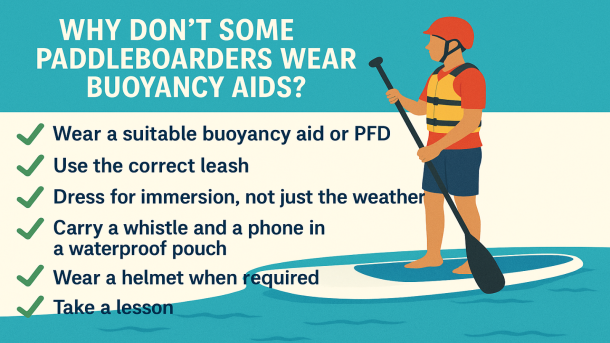As paddleboarding continues to grow in popularity, especially on rivers, lakes and along the coast, an important safety question keeps coming up:
“Why don’t some paddleboarders wear buoyancy aids?”
At Kingston Kayak Club, we’re big advocates of safe, inclusive paddling. So let’s unpack some of the reasons people give for skipping buoyancy aids – and why these often don’t hold up under scrutiny.
“It’s Easy to Get Back On”
Many paddleboarders feel confident in their ability to remount their board if they fall in. They see the board itself as a giant float, making a buoyancy aid seem unnecessary.
The reality:
In calm conditions, getting back on may be easy – but throw in cold water, fatigue, cramp, or choppy conditions, and that task becomes far more difficult. A buoyancy aid gives you the vital support needed to rest, recover and think clearly.
“It Doesn’t Look Cool” or “It’s Uncomfortable”
Let’s face it – some paddlers worry that buoyancy aids spoil the look, especially when they’re paddleboarding in the sunshine or taking photos for social media. Others say they’re too warm or get in the way.
The reality:
Modern PFDs (Personal Flotation Devices) are designed specifically for paddleboarding. They’re lightweight, low-profile, and offer full freedom of movement – so there’s really no excuse. Safety should never be sacrificed for style.
“I’m a Good Swimmer” or “It’s Only Shallow”
A common belief is that strong swimmers or shallow waters don’t require extra buoyancy.
The reality:
Cold water shock, disorientation, strong currents or unexpected slips can affect anyone, no matter their swimming ability. A buoyancy aid buys you crucial time – and can make the difference between a minor incident and a serious emergency.
“No One Else Wears One”
Paddlers often take their cues from what others are doing. If a group or hire centre doesn’t promote buoyancy aid use, it’s easy to assume it’s not necessary.
The reality:
This is a culture we’re trying to change. Clubs, safety bodies and experienced paddlers are now leading the way in modelling safe practice. Just because it’s common doesn’t mean it’s smart.
Outdoor Pool Sessions at Kingston Kayak Club
Our Beginner SUP sessions take place in the safe, clean waters of our outdoor pool at Albert Avenue Pools in Hull. These sessions are a great way to get started with paddleboarding under the guidance of qualified coaches.
However, due to the nature of the environment, all paddleboarders taking part in our outdoor pool sessions are required to wear both a buoyancy aid and a helmet.
This is because of the additional risks present — such as falling onto the poolside, into other paddlers, or onto nearby kayaks and canoes. Helmets help protect against knocks to the head in close quarters, especially for beginners who are more likely to fall.
✅ Top Tips for SUP Safety
-
Wear a suitable buoyancy aid or PFD
-
Use the correct leash – e.g. waist leash for rivers, coiled leash for flatwater
-
Dress for immersion, not just the weather
-
Carry a whistle and a phone in a waterproof pouch
-
Wear a helmet when required
-
Take a lesson – even a short session can boost your confidence and competence
Changing the Culture
There’s sometimes confusion over requirements too. In some areas, wearing a buoyancy aid isn’t a legal obligation, though Paddle UK and most governing bodies strongly recommend them at all times – particularly in open, tidal or inland water.
At Kingston Kayak Club, we always encourage paddlers to wear a buoyancy aid, no matter the craft or conditions. It’s one of the simplest and most effective safety decisions you can make.
Let’s make paddleboarding fun, welcoming, and above all safe.

